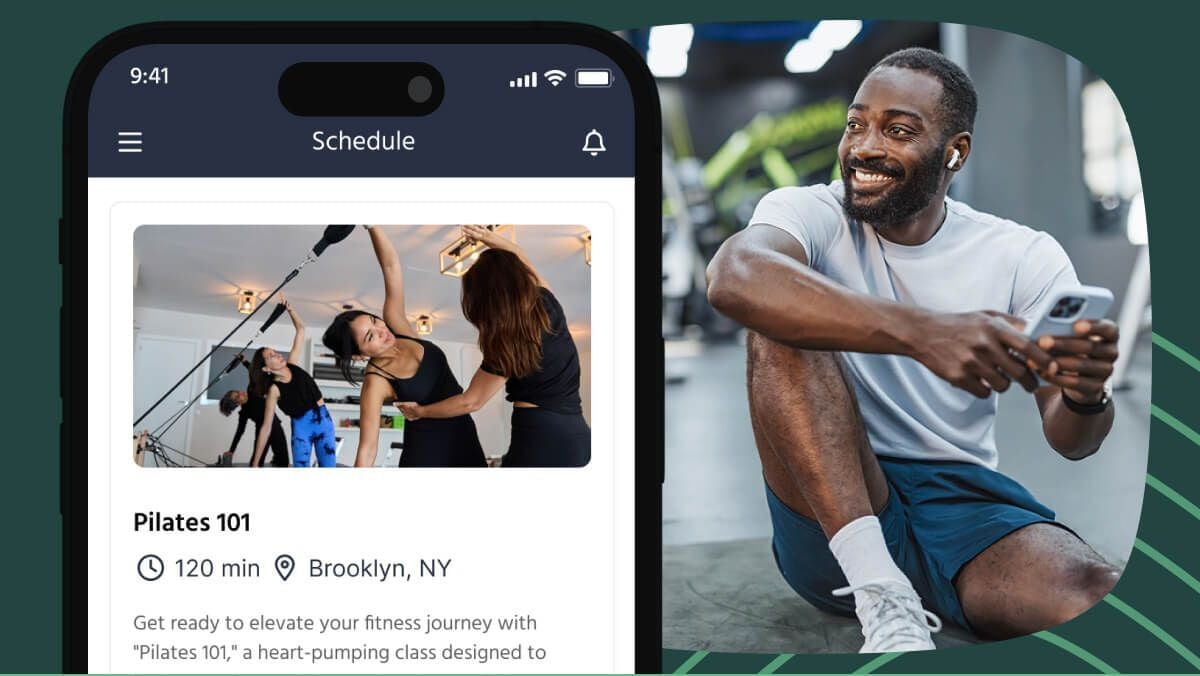From the pre-modern times of Egypt and Pompeii, advertising has been an integral part of marketing efforts. While it has changed throughout the years, the kernel has remained the same. Advertisements are meant to intrigue potential customers to buy from you. For personal trainers, advertising may revolve around the features, experience, benefits, and pricing of your gym and expertise.

However, to see most personal training personnel failing to acknowledge the power of advertising is tragic at best. Through this article, we’ve tried to make personal trainers and gyms promote themselves and acquire leads with the help of modern advertising.
What is modern advertising?
Modern advertising is communicating a message about products and services through mass interactive communication and impersonal means to reach a wide range of audiences who may be interested in what the sponsor has to offer.
Advertising is a paid concept, although the advertiser may be able to reach the target audience without investing exclusively in the positioning of the ads through social media and PSAs. While you may try to deliver a message through advertising, most personal training advertising efforts focus on making the clients aware of the gyms or personal training sessions.
Mostly two types of advertising are widely embraced by marketers in the fitness industry: traditional advertising and digital advertising.
Traditional advertising practices include
-
Print advertising
-
Display advertising
-
Radio advertising
-
Television advertising
-
Referral advertising
And digital advertising efforts include
-
Social media advertising
-
Paid search ads and social media ads
-
Email marketing efforts
-
Podcasts and videos
-
Influencer advertising
-
Mobile advertising (which may go beyond ads on partner sites to other influential channels like notifications and social media)
Traditional marketing is still relevant for personal fitness as there is still scope for building your business locally before jumping on the online bandwagon to reach newer prospects. With that being said, let’s understand the pros and cons of each type of advertising.
Pros and cons of traditional advertising
Great for generating awareness
Traditional advertising, in general, works best for generating awareness in the target audience. As the practices are typically either too fast or too complex to take any action on, placing your personal training brand out in the market is best done with traditional approaches. Mass media including billboards, TV, and stadiums, generate great brand exposure to the mass market. If you already offer online services, public multi-media campaigns can create a huge impact.
Works best when trying to convey emotional elements
When the human touch is absent, which is in most mass media, traditional advertising does a better job of conveying emotional elements. Through videos and direct mails, you can establish an impersonal connection that often does a better job than the spray-and-pray approach of beginner digital marketing efforts.
High-value services work well with traditional advertising
Personal calls and letters establish a better connection with the prospects in case of high-value services. Traditional advertising may secure more clients for the premium services—multi-year programs—than digital advertising, although it all depends on your sales process. Personalized communication and clear interactions are also key advantages of traditional advertising.
Traditional advertising can be expensive
Production, placement, and space together can add up to a huge cost when considering traditional advertising. You can’t get enough engagements through small-scale traditional efforts. Without cash flow to spare on prominent shows, billboards, and TV, traditional strategies mostly end up failing. If you’re considering mails, preparing copies for each prospect may also turn into a costly affair.
Metrics aren’t as efficient as digital advertising
Mass media can’t be tracked as efficiently as digital advertising platforms. While TV viewership and drive-bys can give you an estimation, they still aren’t as accurate as click-throughs and bounce rates.
Can prolong the marketing efforts
Production and placement of traditional marketing materials can take a long time to facilitate. Even after that, once they’re done, they’re done. You can’t change something remotely without starting over. Digital advertisements can be tested and changed as long as you require.
Lacks niche targeting
Except for letters, traditional advertising can’t target niche audiences as efficiently as digital advertising. Keywords, demographics, interests, and many other factors play a major role in sub-segmenting targeting through digital means.
Absence of younger audience
The spenders in today’s market—the Millenials—have turned their back on traditional mass media to a great extent. You should think about reducing everyday TV viewership and newspaper subscriptions before acting on your traditional advertising strategies.
Pros and cons of digital advertising
Digital advertising is cost-effective
Digital advertising is cheaper to produce, doesn’t require printing to distribute, and can be limited to the per-click budget of the sponsor. Digital awareness advertisements are even cheaper than lead generation or conversion ads.
Far greater outreach
Digital isn’t limited by the physicality or zonality of the placements. Unless you particularly exclude areas or demographics from your ads, they can be viewed and accessed by anyone in the world. However, most marketers target specific zones and audiences for better ad performance.
Faster brand awareness
With better and faster reachability, digital advertising can facilitate brand awareness faster than traditional media. However, in most cases, the impact of short-term digital brand awareness ads isn’t as effective as traditional advertising. Consider mixing traditional and digital ads for a more impactful outreach to the target audience.
Better traceability and metrics
Digital advertising is more traceable than traditional practices. As most of the actions on digital platforms are tracked through the interaction of the user with the ads, they can be analyzed and metered for refinement and accuracy. Better traceability empowers you to tweak the ads faster without losing potential clients and revenue.
Better personalization and targeting
You can generate different digital ads for different demographics and channels. While this could also be done with traditional marketing, the resource requirements are much higher and more expensive.
Imagine printing different billboards for different sets of audiences. Also, suppose the differentiation is based on the font style preference. If a single building has multiple parties who’re interested in different font styles, how can you possibly implement them in a single position?
Digital ads can be personalized to target different sets of audiences through different ads.
Intellectual property theft
Digital advertisement strategies and resources are more prone to theft than physical ones. Your competitors aren’t to gain anything significant from stealing your billboards and newspaper ads, but they can imitate your ad success by following your online strategy and tweaking content as per their needs.
Limited by the user base
Not everyone understands or uses the internet. Sometimes, online checkouts, payments, and shipping can be a hassle for seniors or troubled individuals. They still prefer calls and letters over emails and notifications. If you’re a personal trainer with such clients in your portfolio, consider adding a bit of traditional advertising to your digital strategies.
Technical issues can be devastating
Digital advertisements often come crashing down with minimal technical elements like slow websites, poor UI/UX, and rendering issues. In most cases, the prospects move to competitors if everything isn’t parallel to their liking.
Higher competition globally
With better access comes more competition. When you’re a personal trainer offering online services, global competition isn’t something that you should disregard. Digital advertising can bring more competition to your business, but the issue often is trumped by the opportunities it unlocks.
Personal training advertisement types
Let’s discuss the common advertising channels (both traditional and digital) suitable for personal training.
1. Email personal training advertising
Email advertising requires you to have a sales funnel in place before you start. A sales funnel allows you to generate awareness, collect emails, and establish communication with prospects. However, as personal training is quite a general niche, you can start with whatever email list you have of tangential clients.
A few dos and don’ts of email advertising are
-
Do personalize your approach for different individuals. If you don’t have enough information on each lead, consider personalization based on demographics
-
Do track your email opening rates and click through rates
-
Do include prominent call-to-actions to your email
-
Do understand what your clients are seeking and provide value
-
Do focus on the subject line
-
Don’t spam. Acknowledge unsubscribe requests
-
Don’t fill emails with fluff. Keep it short and to the point
-
Don’t include trigger words that may be filtered by the email clients
-
Don’t overuse visuals. They are best left alone for social media
-
Don’t sell out your subscribers’ emails
2. Paid search advertising
Paid search ads are shown in the SERPs as search, image, and shopping results. As these are based on keywords, effective buyer intent keywords can be quite effective for your personal training niche. For example, if you’re certified in VO2 Max and endurance training, keywords like “endurance training near me”, “endurance trainer online”, or “VO2 max best training” may be effective. However, you have to research your own keywords through Google Ads and Keyword Planner Tool to derive the best results.
If you’re new to paid search ads, consider starting with PPC. Pay-per-click (PPC) ads often extract the best results and give you the best metrics. After harvesting enough audience data, you can update your ads to fit conversion or ROAS campaigns better. This way, you can tweak or A/B test your ads without losing much investment or data.
3. Personal training print advertising
Local newspapers, magazines, flyers, brochures, and other printed media are included in print advertising. The only demographic customization you can make with print advertising is the geographic location. Depending on your business location, you can intrigue local prospects to join your gym or personal training session. As printer media can’t target a niche audience, you have to be picky with the ad placement and copywriting.
Magazines, especially industry-specific magazines, attract a lot of tangential audiences to your print ads. If you can place your ad in fitness and bodybuilding-specific magazines, you may have a higher chance of gaining clients than with generic ones.
4. Television advertising
TV commercials of 20, 30, and 60 seconds can generate a lot of awareness for your business if repeated enough. The repetition is what costs the most for TV commercials. However, with TV viewership like the Super Bowl reaching around 100 million every year, getting repeated places in such broadcasts may be challenging or even monetarily exhausting for you.
Several factors also contribute to the efficacy of TV ads:
-
The ad message
-
Ad duration
-
Ad repetition
-
The show or broadcast
-
Audience base
-
And many more
The more frequency, viewership, or duration an ad has, the costlier it will be to run and sustain. Moreover, the production cost of such high-quality videos often reaches tens of thousands of dollars for 30-second ads.
5. Personal training mobile advertising
Mobile advertisement reaches beyond paid searches to in-app ads and other partner websites. For personal trainers offering online services, mobile ads could be a great opportunity to expand their service offerings to other branches of fitness. For example, if your ad appears in a Fitbit experience video, it can direct a lot of interest toward your business.
You may also use QR codes or similar digital elements with traditional advertising materials to be more impactful.
6. Social media advertising
Social media advertising includes promoting your branded content, products, services, and client feedback to interested individuals on different platforms. If you have a significant number of followers on social media, you may share content with them and utilize their social circles to gain new prospects.
However, paid ads with customized demographics also work pretty well for the fitness industry. As fitness and workouts are quite visual, photos and videos of trainers working out, training, or just taking a break can generate significant interactions on social media.
7. Display advertising
Banner ads, pop-up ads, and ads before video content mostly contributes to the display advertising segment. These ads encourage the users to click on them to direct them toward your personal fitness website. However, thanks to the prevalence of such ads on the internet, they’re mostly ignored.
8. Consumer-generated advertising
Most personal fitness enthusiasts frequently post their progress photos and videos throughout their journey. You can leverage this content for consumer-generated advertising. This is an online alternative to referral advertising that revolves around encouraging your clients to influence other fitness enthusiasts to come under your wing.
9. Podcast and video advertising
Personal fitness brands sponsor podcasts or video creators to advertise their services during the episodes. The placement of such ads may be mutually discussed or be kept alone for the creator to decide. The scripts of the advertisements also are either given by the sponsor or created by the uploader.
In many cases, custom coupon codes are used to generate direct selling opportunities through the episodes.
Pro tips on personal training advertising
Identify your target audience
Whatever advertisement type you may choose, first identify and understand your clients. It may take you a few tries to identify your target audience, but you can maximize your advertising and sales efforts after.
Communicate a single message
Don’t over complicate your ads with multiple coupons, offers, or benefits. Focus on what your clients want to hear from your ad and focus on that. If your clients are seeking weight loss training, build your ad around that.
Don’t lose credibility
Try not to give false hopes to clients and lie in the ads. Such clickbaity ads often get discouraged by the platforms and the clients. Stay true to what your clients can realistically achieve with you.
Make the ads easy to navigate
Your prospects shouldn’t fumble with what to do with your ads. If you’re using traditional means, consider using QR codes and clear phone numbers. If online is your forte, make the ads clickable and make the website navigable.
Invest in professional services
Avoid doing it all by yourself. Hire professional ad agencies to develop the ads for you. They may take a few extra bucks for the production or the setup of the ads, but it’ll all be worth it after a while with the ROI you’ll be generating.
Toll-free numbers
Toll-free numbers increase the probability of getting a call-back soon after the ads are placed. If you’re using traditional advertising, a toll-free number is a must for any business—including personal training.
Data metrics
Always fall back on metrics and not intuitions. From paid ads to television, if your intuitions aren’t being supported by data, ditch the ideas or tweak them to see if anything improves.
The bottom line
Hopefully, you’ve understood what it takes to get on with personal training advertising. The pros and cons of traditional/digital advertising have been discussed in this article with a brief about each advertisement model. Moreover, analyze your requirements and follow the tips mentioned to maximize your ad performance.
FAQ about personal training advertising
How do personal trainers advertise?
Personal trainers advertise through traditional and digital media. They thrive on staying realistic, communicative, and helpful.
Traditional or digital advertising, what should you choose?
As a personal trainer, make use of both in ratios determined by past ads. If you’ve gained a fair amount of success through traditional media, put more investment into it and vice versa.
What to post on social media as a personal trainer?
Bodybuilding progress videos, motivational videos, weight loss motivations, milestone achievement announcements, etc., are great pieces of content for social media for personal trainers.









